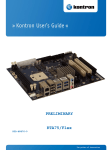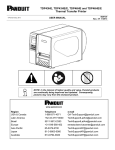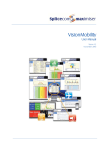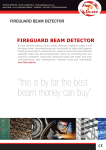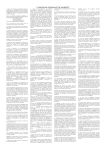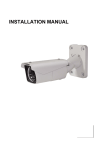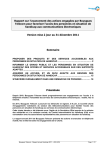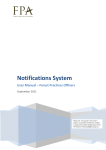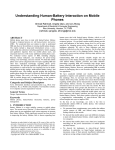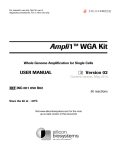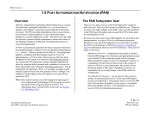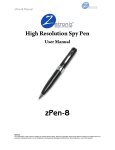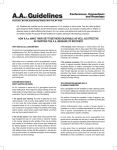Download Version 7.0 ENERGY STAR Program Requirements for Displays
Transcript
EN NERGY STAR® Prrogram Requireme ents cation forr Displays Productt Specific Eligibility Criteria Vers sion 7.0 Following is the Versio on 7.0 ENERG GY STAR product specifica ation for Displays. A produ uct shall meett all of he ENERGY STAR. the identiffied criteria if it is to earn th 1 DEF FINITION NS A) Product Types s: 1) E lectronic c Display (Display): A pro oduct with a display screen and asso ociated electronics, cased in a sin ngle housing,, that as its p rimary functiion produces visual inform mation often enc e inputs (e.g., VGA, DVI, HDMI, from (1) a computer, workstation, or server via one or more ort, IEEE 139 94, USB), (2) external stora age (e.g., US SB flash drive, memory carrd), or DisplayPo (3) a netw work connection. a) Monitor: An Ele ectronic Displa ay intended fo or one person n to view in a desk based nvironment. en b) S ig gnage Display: An Electronic Display in ntended for multiple people e to view in no on esk based env vironments, such as retail or departmen nt stores, resttaurants, de useums, hote els, outdoor ve enues, airporrts, conferencce rooms or cllassrooms. Fo or the mu urposes of this s specification n, a Display s hall be classified as a Signage Displayy if it pu eets two or more criteria lis sted below: me (1) Diagonal sc creen size is greater than 3 0 inches; 0 candelas pe (2) Maximum Reported Lum minance is gre eater than 400 er square me eter; (3) Pixel densitty is less than n or equal to 5 ,000 pixels per square incch; or (4) Ships witho out a mounting stand. B) Operational Mo odes: 1) On Mode: The mode in n which the Display has be een activated, and is providing the primary function. 2) S leep Mo ode: A low-pow wer mode in which the Dissplay providess one or more e non-primaryy protective e functions or continuous fu unctions. Note: Sleep Mode may y serve the fo ollowing functiions: facilitate e the activatio on of On Mode via witch, Touch Technology, internal senso or, or timer; provide inform mation or statu us remote sw cks; support sensor-based functions; or maintain a ne etwork presen nce. displays including cloc 3) O ff Mode: The mode where the Display is conne ected to a pow wer source, produces no visual on, and canno ot be switched d into any oth her mode with h the remote control unit, an informatio internal signal, or an external signal. Note: The e Display may y only exit this s mode by dirrect user actu uation of an in ntegrated pow wer switch or control. Some products may not have a n Off Mode. C) Visual Charactteristics: 1) A mbient Light Conditio ons: The combination of lig ght illuminancces in the envvironment ving room or a n office. surrounding a Display,, such as a liv ENERGY ST TAR Program Re equirements for Displays – Eligib bility Criteria Page 1 of 10 2) Automatic Brightness Control (ABC): The self-acting mechanism that controls the brightness of a Display as a function of Ambient Light Conditions. Note: ABC functionality must be enabled to control the brightness of a Display. 3) Color Gamut: Color gamut area shall be reported as a percentage of the CIE LUV 1976 u' v' color space and calculated per Section 5.18 Gamut Area of the Information Display Measurements Standard Version 1.03. Note: Any gamut support in non-visible/invisible color areas is not to be counted. The gamut’s size must be expressed as a percentage of area of the visible CIE LUV color space only. 4) Luminance: The photometric measure of the luminous intensity per unit area of light travelling in a given direction, expressed in candelas per square meter (cd/m2). a) Maximum Reported Luminance: The maximum luminance the Display may attain at an On Mode preset setting, and as specified by the manufacturer, for example, in the user manual. b) Maximum Measured Luminance: The maximum measured luminance the Display may attain by manually configuring its controls, such as brightness and contrast. c) As-shipped Luminance: The luminance of the Display at the factory default preset setting the manufacturer selects for normal home or applicable market use. 5) Native Vertical Resolution: The number of physical lines along the vertical axis of the Display within the visible area of the Display. Note: A Display with a screen resolution of 1920 x 1080 (horizontal x vertical) would have a Native Vertical Resolution of 1080. 6) Screen Area: The visible area of the Display that produces images. Note: Screen Area is calculated by multiplying the viewable image width by the viewable image height. For curved screens, measure the width and height along the arc of the Display. D) Additional Functions and Features: 1) Bridge Connection: A physical connection between two hub controllers (i.e., USB, FireWire). Note: Bridge Connections allow for expansion of ports typically for the purpose of relocating the ports to a more convenient location or increasing the number of available ports. 2) Full Network Connectivity: The ability of the Display to maintain network presence while in Sleep Mode. Presence of the Display, its network services, and its applications, is maintained even if some components of the Display are powered down. The Display can elect to change power states based on receipt of network data from remote network devices, but should otherwise stay in Sleep Mode absent a demand for services from a remote network device. Note: Full Network Connectivity is not limited to a specific set of protocols. Also referred to as “network proxy” functionality and described in the Ecma-393 standard. 3) Occupancy Sensor: A device used to detect human presence in front of or in the area surrounding a Display. Note: An Occupancy Sensor is typically used to switch a Display between On Mode and Sleep Mode. ENERGY STAR Program Requirements for Displays – Eligibility Criteria Page 2 of 10 4) Touch Technology: Enables the user to interact with a product by touching areas on the Display screen. 5) Plug-in Module: A modular plugin device that provides one or more of the following functions without the explicit purpose of providing general computing function: a) Display images, mirror remote content streamed to it, or otherwise render content on the screen from local or remote sources; or b) Process touch signals. Note: Modules providing any other additional input options are not considered Plug-in Modules for the purposes of this specification. E) Product Family: A group of product models that (1) are made by the same manufacturer, (2) share the same Screen Area, Resolution, and Maximum Reported Luminance, and (3) are of a common basic screen design. Models within a Product Family may differ from each other according to one or more characteristics or features. For Displays, acceptable variations within a Product Family include: 1) External housing; 2) Number and types of interfaces; 3) Number and types of data, network, or peripheral ports; and 4) Processing and memory capability. F) Representative Model: The product configuration that is tested for ENERGY STAR certification and is intended to be marketed and labeled as ENERGY STAR. G) Power Source 1) External Power Supply (EPS): An external power supply circuit that is used to convert household electric current into dc current or lower-voltage ac current to operate a consumer product. 2) Standard dc: A method for transmitting dc power defined by a well-known technology standard, enabling plug-and-play interoperability. Note: Common examples are USB and Power-over-Ethernet. Usually Standard dc includes both power and communications over the same cable, but as with the 380 V dc standard, that is not required. 2 SCOPE 2.1 Included Products 2.1.1 Products that meet the definition of a Display as specified herein and are powered directly from ac mains, an External Power Supply, or Standard dc are eligible for ENERGY STAR certification, with the exception of products listed in Section 2.2. Typical products that would be eligible for certification under this specification include: i. Monitors; ii. Monitors with keyboard, video, and mouse (KVM) switch functionality; iii. Signage Displays; and iv. Signage Displays and Monitors with Plug-in Modules. 2.2 E xcluded Products ENERGY STAR Program Requirements for Displays – Eligibility Criteria Page 3 of 10 2.2.1 Products that are covered under other ENERGY STAR product specifications are not eligible for certification under this specification including Televisions and Computers (Thin Clients, Slates/Tablets, Portable All-in-one Computers, Integrated Desktops). The list of specifications currently in effect can be found at www.energystar.gov/products. 2.2.2 The following products are not eligible for certification under this specification: i. Products with an integrated television tuner; ii. Displays with integrated or replaceable batteries designed to support primary operation without ac mains or external dc power, or device mobility (e.g., electronic readers, batterypowered digital picture frames); and iii. Products that must meet Food and Drug Administration specifications for medical devices that prohibit power management capabilities and/or do not have a power state meeting the definition of Sleep Mode. 3 CERTIFICATION CRITERIA 3.1 Significant Digits and Rounding 3.1.1 All calculations shall be carried out with directly measured (unrounded) values. 3.1.2 Unless otherwise specified, compliance with specification requirements shall be evaluated using directly measured or calculated values without any benefit from rounding. 3.1.3 Directly measured or calculated values that are submitted for reporting on the ENERGY STAR website shall be rounded to the nearest significant digit as expressed in the corresponding specification requirements. 3.2 General Requirements for Monitors and Signage Displays 3.2.1 External Power Supplies (EPSs): Single- and Multiple-voltage EPSs shall meet the Level VI or higher performance requirements under the International Efficiency Marking Protocol when tested according to the Uniform Test Method for Measuring the Energy Consumption of External Power Supplies, Appendix Z to 10 CFR Part 430. i. Single- and Multiple-voltage EPSs shall include the Level VI or higher marking. ii. Additional information on the Marking Protocol is available at http://www.regulations.gov/#!documentDetail;D=EERE-2008-BT-STD-0005-0218. 3.2.2 Power Management: i. Products shall offer at least one power management feature that is enabled by default, and that can be used to automatically transition from Sleep Mode to On Mode either by a connected host device or internally (e.g., support for VESA Display Power Management Signaling (DPMS), enabled by default). ii. Products that generate content for display from one or more internal sources shall have a sensor or timer enabled by default to automatically engage Sleep or Off Mode. iii. For products that have an internal default delay time after which the product transitions from On Mode to Sleep Mode or Off Mode, the delay time shall be reported. iv. Monitors shall automatically enter Sleep Mode or Off Mode within 5 minutes of being disconnected from a host computer. ENERGY STAR Program Requirements for Displays – Eligibility Criteria Page 4 of 10 3.2.3 Signage Displays shall have a true power factor in On Mode of 0.7 or greater per Section 5.2.F) in the ENERGY STAR Test Method. 3.3 Energy Requirements for Computer Monitors 3.3.1 The Total Energy Consumption (TEC) in kWh shall be calculated per Equation 1 based on measured values. Equation 1: Total Energy Consumption Calculation ்ܧா ൌ 8.76 ൈ ሺ0.35 ൈ ܲைே 0.65 ൈ ܲௌாா ሻ Where: ETEC is the Total Energy Consumption calculation in kWh; PON is Measured On Mode Power in watts PSLEEP is Measured Sleep Mode Power in watts; and The result shall be rounded to the nearest tenth of a kWh for reporting. 3.3.2 The Maximum TEC (ETEC_MAX) in kWh for Monitors shall be calculated per Table 1. Table 1: Calculation of Maximum TEC (ETEC_MAX) for Monitors in kWh ETEC Max (kWh) 2 Area (in ) Where: 2 A = Viewable screen area in in r = Screen resolution in megapixels The result shall be rounded to the nearest tenth of a kWh for reporting A < 130 ሺ6.13 ൈ ݎሻ ሺ0.06 ൈ ܣሻ 9 130 ≤ A <150 150 ≤ A <180 180 ≤ A < 200 200 ≤ A <230 230 ≤ A <280 280 ≤ A <300 300 ≤ A <500 A ≥ 500 ሺ6.13 ൈ ݎሻ ሺ0.69 ൈ ܣሻ െ 72.38 ሺ6.13 ൈ ݎሻ ሺ0. 21 ൈ ܣሻ െ 0.50 ሺ6.13 ൈ ݎሻ ሺ0.05 ൈ ܣሻ 28 ሺ6.13 ൈ ݎሻ ሺ0.03 ൈ Aሻ 31.33 ሺ6.13 ൈ ݎሻ ሺ0.2 ൈ ܣሻ െ 7 ሺ6.13 ൈ ݎሻ 49 ሺ6.13 ൈ ݎሻ ሺ0.2 ൈ ܣሻ െ 11 89 3.3.3 For all Monitors, Calculated TEC (ETEC) in kWh shall be less than or equal the calculation of Maximum TEC (ETEC_MAX) with the applicable allowances and adjustments (applied at most once) per Equation 2. ENERGY STAR Program Requirements for Displays – Eligibility Criteria Page 5 of 10 Equation 2: Total Energy Consumption Requirement for Monitors ்ܧா ሺ்ܧா_ெ ܧா ܧ ܧே ܧைௌ ்ܧሻ ൈ ݂݂݁_ Where: ETEC is TEC in kWh calculated per Equation 1; ETEC_MAX is the Maximum TEC requirement in kWh calculated per Table 1; EEP is the enhanced performance display allowance in kWh per Section 3.3.4; EABC is the Automatic Brightness Control allowance in kWh per Equation 4; EN is the Full Network Connectivity allowance in kWh per Table 3; EOS is the Occupancy Sensor allowance in kWh per Table 4; ET is the Touch Technology allowance in kWh per Equation 5; and effAC_DC is the standard adjustment for ac-dc power conversion losses that occur at the device powering the Display, and is 1.0 for Ac-powered Displays and 0.85 for Displays with Standard dc. 3.3.4 For Monitors meeting the enhanced performance display (EPD) requirements below, only one of the following Table 2 allowances shall be used in Equation 2: i. Contrast ratio of at least 60:1 measured at a horizontal viewing angle of at least 85° from the perpendicular on a flat screen and at least 83° from the perpendicular on a curved screen, with or without a screen cover glass; ii. A native resolution greater than or equal to 2.3 megapixels (MP); and iii. Color Gamut greater than or equal to 32.9% of CIE LUV. Table 2: Calculation of Energy Allowance for Enhanced Performance Displays EEP (kWh) Where: ETEC_MAX is the Maximum TEC requirement in kWh; and r is screen resolution in megapixels Color Gamut Criteria Color Gamut support is 32.9% of CIE LUV or greater. 0.15 ൈ ൫்ܧாಾಲ െ 6.13 ൈ ݎ൯ Color Gamut support is 38.4% of CIE LUV or greater. 0.65 ൈ ൫்ܧா_ெ െ 6.13 ൈ ݎ൯ Note: A model supporting greater than 99% of the sRGB color space translates to 32.9% of CIE LUV and a model supporting greater than 99% of Adobe RGB translates to 38.4% of CIE LUV. 3.3.5 For monitors with Automatic Brightness Control (ABC) enabled by default, an energy allowance (EABC), as calculated per Equation 4, shall be added to ETEC_MAX in Equation 2, if the On Mode power reduction (RABC), as calculated per Equation 3, is greater than or equal to 20%. Equation 3: Calculation of On Mode Reduction with ABC Enabled by Default ܴ ൌ 100% ൈ ൬ Where: ܲଷ െ ܲଵଶ ൰ ܲଷ RABC is the On Mode percent power reduction due to ABC; P300 is the On Mode power in watts, as measured at an ambient light level of 300 lux in Section 6.4 of the Test Method; and P12 is the On Mode power in watts, as measured at an ambient light level of 12 lux in Section 6.4 of the Test Method. ENERGY STAR Program Requirements for Displays – Eligibility Criteria Page 6 of 10 Equation 4: Monitors ABC Energy Allowance (EABC) for Monitors ܧ ൌ 0.05 ൈ ்ܧா_ெ Where: EABC is the energy allowance for Automatic Brightness Control in kWh; and ETEC_MAX is the Maximum TEC in kWh, per Table 1. 3.3.6 Products with Full Network Connectivity confirmed in Section 6.7 of the ENERGY STAR Test Method shall apply the allowance specified in Table 3. Table 3: Full Network Connectivity Energy Allowance (EN) for Monitors EN (kWh) 2.9 3.3.7 Products tested with an Occupancy Sensor active shall apply the allowance specified in Table 4. Table 4: Additional Functions Energy Allowance (EOS) for Monitors Type Occupancy Sensor EOS Allowance (kWh) 1.7 3.3.8 Products tested with Touch Technology active in On Mode shall apply the allowance specified in Equation 5. Equation 5: Energy Allowance for Touch Technology (ET) for Monitors ்ܧൌ 0.15 ൈ ்ܧா_ெ Where: 3.4 ET is the energy allowance for Touch Technology in kWh; and ETEC_MAX is the Maximum TEC in kWh, per Table 1. On Mode Requirements for Signage Displays 3.4.1 The Maximum On Mode Power (PON_MAX) in watts shall be calculated per Equation 6. Equation 6: Calculation of Maximum On Mode Power (PON_MAX) in Watts for Signage Displays ܲைே_ெ ൌ ሺ4.0 ൈ 10ିହ ൈ ℓ ൈ ܣሻ 119 ൈ ݄݊ܽݐሺ0.0008 ൈ ሺ ܣെ 200.0ሻ 0.11ሻ 6 Where: PON_MAX is the Maximum on Mode Power, in watts; A is the Screen Area in square inches; ℓ is the Maximum Measured Luminance of the Display in candelas per square meter, as measured in Section 6.2 of the test method; tanh is the hyperbolic tangent function; and The result shall be rounded to the nearest tenth of a watt for reporting. ENERGY STAR Program Requirements for Displays – Eligibility Criteria Page 7 of 10 Equation 7: On Mode Power Requirement for Signage Displays ܲைே ܲைே_ெ ܲ Where: PON is On Mode Power in watts, as measured in Section 6.3 or 6.4 of the Test Method; PON_MAX is the Maximum On Mode Power in watts, per Equation 7; and PABC is the On Mode power allowance for ABC in watts, per Equation 8. 3.4.2 For Signage Displays with ABC enabled by default, a power allowance (PABC), as calculated per Equation 8, shall be added to PON_MAX, as calculated per Equation 6, if the On Mode power reduction (RABC), as calculated per Equation 3, is greater than or equal to 20 percent. Equation 8: Calculation of On Mode Power Allowance for Signage Displays with ABC Enabled by Default ܲ ൌ 0.05 ൈ ܲைே_ெ Where: 3.5 PABC is the Measured On Mode Power allowance for ABC in watts; and PON_MAX is the Maximum On Mode Power requirement in watts. Sleep Mode Requirements for Signage Displays 3.5.1 Measured Sleep Mode Power (PSLEEP) in watts shall be less than or equal the sum of the Maximum Sleep Mode Power Requirement (PSLEEP_MAX) and any allowances (applied at most once) per Equation 9. Equation 9: Sleep Mode Power Requirement for Signage Displays ܲௌாா ܲௌாாಾಲ ܲே ܲைௌ ்ܲ Where: PSLEEP is Measured Sleep Mode Power in watts; PSLEEP_MAX is the Maximum Sleep Mode Power requirement in watts per Table 5; PN is the Full Network Connectivity allowance in watts per Table 6; POS is the Occupancy Sensor allowance in watts per Table 7; and PT is the Touch allowance in watts per Table 7. Table 5: Maximum Sleep Mode Power Requirement (PSLEEP_MAX) for Signage Displays PSLEEP_MAX (watts) 0.5 3.5.2 Products with Full Network Connectivity confirmed in Section 6.7 of the ENERGY STAR Test Method shall apply the allowance specified in Table 6. Table 6: Full Network Connectivity Allowance for Signage Displays PN (watts) 3.0 ENERGY STAR Program Requirements for Displays – Eligibility Criteria Page 8 of 10 3.5.3 Products tested with an Occupancy Sensor or Touch Technology active in Sleep Mode shall apply the allowances specified in Table 7. Table 7: Additional Functions Sleep Mode Power Allowance for Signage Displays Type Occupancy Sensor POS Touch Functionality PT Screen Size (in) Allowance (watts) All 0.3 ≤ 30 0.0 > 30 1.5 (applicable only to Signage Displays where screen size is greater than 30 inches) 3.6 Off Mode Requirements for all Displays 3.6.1 A product need not have an Off Mode to be eligible for certification. For products that do offer Off Mode, measured Off Mode power (POFF) shall be less than or equal to the Maximum Off Mode Power Requirement (POFF_MAX) in Table 8. Table 8: Maximum Off Mode Power Requirement (POFF_MAX) POFF_MAX (watts) 0.5 3.7 L uminance Reporting Requirements 3.7.1 Maximum Reported and Maximum Measured Luminance shall be reported for all products; AsShipped Luminance shall be reported for all products except those with ABC enabled by default. Note: Products intended for sale in the US market are subject to minimum toxicity and recyclability requirements. Please see ENERGY STAR® Program Requirements for Displays: Partner Commitments for details. 4 TEST REQUIREMENTS 4.1 Test Methods 4.1.1 Test methods identified in Table 9 shall be used to determine certification for ENERGY STAR. ENERGY STAR Program Requirements for Displays – Eligibility Criteria Page 9 of 10 Table 9: Test Methods for ENERGY STAR Certification Product Type Test Method All Product Types and Screen Sizes ENERGY STAR Test Method for Determining Display Energy – Rev. Sep-2015 Enhanced Performance Displays Displays Claiming Full Network Connectivity 4.2 International Committee for Display Metrology (ICDM) Information Display Measurements Standard – Version 1.03 CEA-2037-A, Determination of Television Set Power Consumption Number of Units Required for Testing 4.2.1 One unit of a Representative Model, as defined in Section 1, shall be selected for testing. 4.2.2 For certification of a Product Family, the product configuration that represents the worst-case power demand for each product category within the Product Family shall be considered the Representative Model. 4.3 International Market Qualification 4.3.1 Products shall be tested for qualification at the relevant input voltage/frequency combination for each market in which they will be sold and promoted as ENERGY STAR. 5 USER INTERFACE 5.1.1 Manufacturers are encouraged to design products in accordance with the user interface standard, IEEE P1621: Standard for User Interface Elements in Power Control of Electronic Devices Employed in Office/Consumer Environments. For details, see http://energy.lbl.gov/controls/. 6 EFFECTIVE DATE 6.1.1 Effective Date: The Version 7.0 ENERGY STAR Display specification shall take effect on July 1, 2016. To qualify for ENERGY STAR, a product model shall meet the ENERGY STAR specification in effect on its date of manufacture. The date of manufacture is specific to each unit and is the date on which a unit is considered to be completely assembled. 6.1.2 Future Specification Revisions: EPA reserves the right to change this specification should technological and/or market changes affect its usefulness to consumers, industry, or the environment. In keeping with current policy, revisions to the specification are arrived at through stakeholder discussions. In the event of a specification revision, please note ENERGY STAR certification is not automatically granted for the life of a model 7 CONSIDERATIONS FOR FUTURE REVISIONS 7.1.1 On Mode DC Power Limit: EPA is interested in considering a separate On Mode Power Maximum requirement for Standard dc products that does not necessitate an ac-dc conversion calculation. EPA anticipates these products will become more popular on the market with the latest USB standard and looks forward to receiving additional direct dc-tested data for these products. ENERGY STAR Program Requirements for Displays – Eligibility Criteria Page 10 of 10











